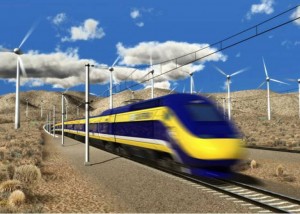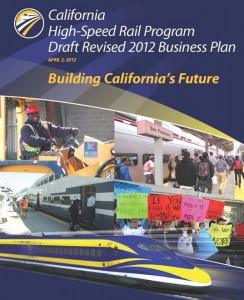 The California High-Speed Rail Authority Monday released a revised Business Plan, to launch the nation’s first high-speed rail service—capable of traveling 220 miles-per-hour from Merced through Bakersfield and Palmdale to the San Fernando Valley—within ten years.
The California High-Speed Rail Authority Monday released a revised Business Plan, to launch the nation’s first high-speed rail service—capable of traveling 220 miles-per-hour from Merced through Bakersfield and Palmdale to the San Fernando Valley—within ten years.
“Our revised plan makes high-speed rail better, faster and cheaper,” High-Speed Rail Authority Chairman Dan Richard told a news conference today at the Southern Pacific Building in Fresno. “Drawing on hundreds of public comments as well as the expertise of our technical staff, we were able to refine our thinking and improve the plan enormously. The revised plan will enhance local rail service immediately and, in the long term, cut total project costs by $30 billion.”
Under the revised 2012 Business Plan, construction begins this year on the 300-mile Initial Operating Section, that would extend from Merced through Bakersfield and Palmdale to the San Fernando Valley. The new plan also improves the safety and efficiency of existing urban rail systems to ultimately allow the integration of local systems with high-speed rail.
The key changes to the revised business plan include:
- Constructing 300 miles of electrified rail from Merced to San Fernando Valley in ten years;
- Improving existing rail service in the Bay Area and Los Angeles regions to prepare those systems for high-speed rail service;
- Cutting $30 billion in costs, through the blended approach, cost savings and inflation assumptions; and
- The potential to access cap & trade funds as a backstop to federal funding.
“In ten years, Californians will be able to travel through the Central Valley and into the Los Angeles Basin in half the time it takes to drive,” said Governor Edmund G. Brown Jr. “This revised plan is bold, practical and puts California out in front once again.”
 Construction of the entire 520-mile rail system will finish in 2028, with service to begin in 2029. Under the new plan, the system will cost $68.4 billion in year-of-expenditure dollars, a $30 billion reduction over the previous plan.
Construction of the entire 520-mile rail system will finish in 2028, with service to begin in 2029. Under the new plan, the system will cost $68.4 billion in year-of-expenditure dollars, a $30 billion reduction over the previous plan.
Six billion dollars in funding has already been identified for the first segment of the Initial Operating Section, including $3.3 billion in federal funding and $2.7 billion in voter-approved Proposition 1A bond proceeds. Cap and trade funds are also available as a backstop against federal and local support to complete the initial operating section. No operating subsidy will be required.
“The plan is realistic, credible and transparent,” said Authority Board Member Mike Rossi. “This plan is responsible from a business perspective and is a solid investment for Californians. There is no need for operating subsidies and the system will attract private capital once the operating segment stabilizes ridership in 2022.”
The plan will be reviewed at the High-Speed Rail Authority Board’s April 12 meeting. View the entire HSRA Revised 2012 Draft Business Plan here. To see a guide to the changes click here.
(Information via press release from California High Speed Rail Authority.)
Larry Scheib says
Amtrak was subsidized at 1/2 billion last year. And all that went to the inefficient long haul routs.
All transportation is subsidized. So whats your point?
William says
Thank you for pointing these things out. I imagine fire departments don’t make a profit either.
Larry Scheib says
There is going to be a percentage of taxes spent on transportation regardless of the state of the economy. It’s not like they shift 2 billion from HSR to education; budgets don’t work that way. Also, a big chunk of the money is Fed. If rejected it will end up being used in New York or Illinois or some other state that would be glad to have it.
Also, this would be a much bigger job creator (economic boost) than say the Keystone pipeline would ever be. And every rail system I’ve seen installed as generated tremendous amounts of nearby business development which has led to more tax revenue.
Building more jails? I think we need to look at why our jails are so crowded before spending more money on them.
William says
I love the “If it’s so great…..” line of thinking. I’ve heard people say “If it’s so great, why isn’t it free” and other nonsense. Do not, I repeat, do not start a statement with “If it’s so great….”.
D. Lamont says
Why so negative? The HSR will provide jobs, get lots of cars off the road, and reduce pollution. And according to the article the new plan also improves existing rail systems. It will also be a boon for Palmdale. I think the High Speed Rail could be a good thing. I wouldn’t write this off as a money pit just yet.
If it was I don’t think it would have received all the suppose it has gotten from Palmdale leadership. Just a thought…
.. says
Well of course Palmdale is going to support it. Any time a city gets “free stuff” to help put them on the map, why wouldn’t they support it.
The rail is a stupid and wasteful idea. One only needs to look at all the profit Amtrak makes (NOT), to see how profitable it is.
TruthsAvenger says
BOONDOGGLE!!!!! Wouldn’t that $30 billion be better used to cut the budget gap and put more funds toward fixing existing roads and rails, not to mention law enforcement at education?
Just saying…..
Larry Scheib says
I think it is a great plan. It is more in line with what is happening in Illinois and New England where Amtrak doesn’t need subsidizing, except it will get to 200+ mph sooner. Sure there is an upfront cost, but when compared to what equivalent highways and Airports would cost its a great deal. Hell, California spends 20-30 billion a year alone subsidizing highway maintenance.
In “boondoggle producing countries” such as Germany and Japan, HSR is used by professionals, tourist and everybody else. It’s not relegated to lower classes. Even if it is relegated to lower class won’t that free up more highway lanes for “you”? And won’t it take more older, cheaper and CO2 producing clunkers off the roads?
.. says
“California spends 20-30 billion a year alone subsidizing highway maintenance”
First, taxpayers pay for that. Secondly, even you would agree that highway maintenance serves more people than this train, right?
“Even if it is relegated to lower class won’t that free up more highway lanes for “you”?”
I never thought about it that way. You’re right! Ever since the Metrolink came up to the AV, I’ve not experienced any gridlock or traffic congestion on the 14. The train solves all those problems.
Larry Scheib says
Yes, Tax payers pay for the highway maintenance…so! That’s what subsidizing is. Of course the highway serves more people now, since the HSR doesn’t exist yet! Acela has a 40+% of the train/plane segment in the routes it serves; this for a train that rarely exceeds 100 mph. (I’ll have to do some more research but I’m sure it impacts road travel significantly also). I’ll take your word for it on gridlock; I know I never experience gridlock because I always either bike or use public transportation. You should try it. No car insurance, no gas cost, no road rage, no traffic jams and etc.
.. says
Larry, you need to get out more and realize that public transportation, including Metrolink and other forms of public transportation only work, when one is actually able to get where they need to go in a reasonable amount of time. If one lives or works no where near any of these forms of public transportation, then their benefits aren’t all that great. Certainly not worth the price of this stupid HSR
Larry Scheib says
I’m sure I’ve done a lot more traveling and used more transportation systems then you will ever dream of…get out more, give me a break. Your correct, the more built out a system the more people it is advantageous to, but you have to start somewhere. If you look at the public transportation systems of such cities as Melbourne Australia (local rail) and Munich (HSR) you would see what the US cities should aspire to be like – fully integrated and accessible. We just need to get rid of our 19th century politicians and thinking and build out our systems to impact the highest percentages of potential riders. Looking at the commuter rail systems being built (all still have a ways to go) such as Phoenix, Seattle, Portland, etc and there were the same naysayers at the beginning but now the fruits are starting to payoff even though the systems are in there infancy’s. The area of Cali that is investing in HSR has similar demographics as many of the successful systems in Europe. Taxes support all systems to some degree whether it be rail, air or highway. And to fully maximize a system of rail it needs a built-up-network like the highway and Airway systems have gotten.
.. says
But Larry.. honestly… in THIS economy, with the state going broke, and us taxpayers being asked to cough up more to make up the difference? Is *this* really the best time to spend all that money on something that will benefit so few, and won’t be completed in our lifetime? This, at a time when prisoners are being let out of jail, because there is no money? This, at a time when budgets of CalFire and others are being slashed? Is this really a good time to spend money on this?
.. says
Chill out Ace… I’m on your side. this HSR sucks the big one.
Why not use my real name? Simple. Because people like you, and others start whining about who posters “really are” (DBW, Parrisites, etc). The subject of debate should be the message, not the name behind the message.